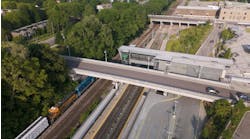A ground-breaking ceremony was held March 14 for the Los Angeles World Airports’ (LAWA) Automated People Mover (APM) project at Los Angeles International Airport (LAX). Stakeholders say the project will transform public transportation, reduce traffic congestion and deliver a world-class experience for travelers at LAX.
The train will connect travelers directly to airport terminals and create new and convenient locations for passenger pick-up and drop-off outside the Central Terminal Area. The Automated People Mover is the centerpiece of the Landside Access Modernization Program (LAMP), which also includes a Consolidated Rent-A-Car (ConRAC) facility and associated roadway improvements. The APM will be completed in 2023 and will have trains arriving every two minutes. The APM will connect with L.A. Metro's light-rail system when it is completed and is expected to serve 30 million travelers annually.
“Everyone traveling to or from LAX should have access to modern, reliable public transportation that gets them to their destination on time,” said Los Angeles Mayor Eric Garcetti. “The Automated People Mover is a historic investment in our city’s transportation infrastructure — a milestone that will create middle-class jobs, reduce traffic congestion, and deliver a world-class experience for travelers.”
LAX Integrated Express Solutions (LINXS) joint venture was awarded a $4.9-billion contract in April 2018 to design, build, finance, operate and maintain the project during a 30-year period. The contract was the largest ever awarded in the city’s history and the JV team has been focused on finalizing the design of the guideway, operations systems and stations along the 2.25-mile path, which now allows for the start of major construction on the project.
The city explains that the LINXS team partners, Fluor Corporation, Balfour Beatty, ACS Infrastructure Development, Dragados USA, Hochtief PPP Solutions, Flatiron, HDR and HNTB, have extensive experience building and operating APMs domestically and internationally.
“We are eager to officially begin the construction and advancement of LAX’s world-class facilities,” said Terence Easton, president of Fluor’s infrastructure business. “This project is a signature piece of mega infrastructure that will be ready to welcome the 2028 Summer Olympics, will improve mobility for travelers from around the world and empower progress for the Los Angeles region for generations to come.”
The project is expected to create more than 2,000 construction jobs. During the design and construction phases, LINXS has committed to 30 percent local hiring, which exceeds local hiring requirements and, together with LAWA, is developing opportunities for local small businesses. LINXS has also agreed to place first-period apprentices from HireLAX and other pre-apprenticeship programs.
“The LINXS consortium is proud to celebrate this meaningful milestone with our partner, LAWA,” said Gregory Amparano, LINXS Board Chair. “Together, we bring the combined international P3 expertise of our joint-venture partners and are excited to collaborate with LAWA on creating a world-class experience at LAX while we honor our commitment to provide local hiring opportunities to the Los Angeles workforce. I am pleased to share that LINXS has committed $115 million to-date in signed contracts to local, small and disabled veteran business subcontractors.”
Following construction, LINXS Operators, comprised of Fluor, ACS, Bombardier and Hochtief, will provide approximately 25 years of operations and maintenance services.

Mischa Wanek-Libman | Group Editorial Director
Mischa Wanek-Libman is director of communications with Transdev North America. She has more than 20 years of experience working in the transportation industry covering construction projects, engineering challenges, transit and rail operations and best practices.
Wanek-Libman has held top editorial positions at freight rail and public transportation business-to-business publications including as editor-in-chief and editorial director of Mass Transit from 2018-2024. She has been recognized for editorial excellence through her individual work, as well as for collaborative content.
She is an active member of the American Public Transportation Association's Marketing and Communications Committee and served 14 years as a Board Observer on the National Railroad Construction and Maintenance Association (NRC) Board of Directors.
She is a graduate of Drake University in Des Moines, Iowa, where she earned a Bachelor of Arts degree in Journalism and Mass Communication.


